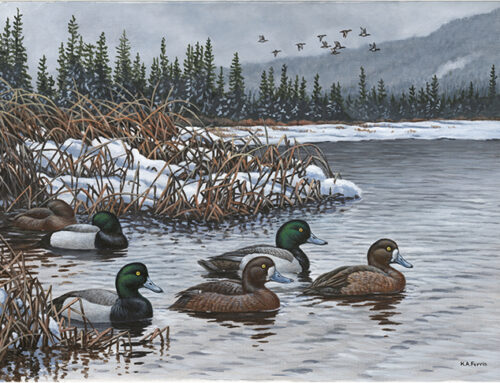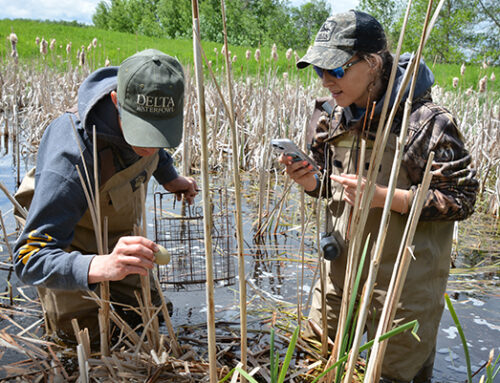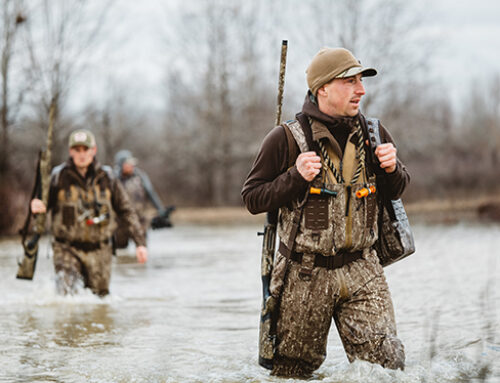We Hunt the Fall Flight

The number of young ducks migrating south is critical to hunter success
For decades, hunters have greatly anticipated the release of the U.S. Fish and Wildlife Service Waterfowl Breeding Population and Habitat Survey each summer. It has always been a moment in time when we get a glimpse of what fall duck season might be like.
What if I told you that the numbers provided by the Breeding Population Survey’s annual estimate of populations of mallards, gadwall, spoonies and bluebills, might not be the best indicators of what the season might hold or what you see over your decoys?
For years, the USFWS, Delta Waterfowl and your local outdoor writer have made a big deal out of the breeding duck numbers, as well they should. The breeding estimates provided by the USFWS are the most extensive wildlife survey conducted anywhere in the world — and the survey has been conducted generally in the same way since 1955. This allows managers to see how populations are faring, not just in one year or in one locale, but over the whole waterfowl breeding range during decades. Also, remember the annual breeding population data is used to calculate duck season length and general duck bag limits, as well as species-specific bag limits for pintails, canvasbacks, bluebills and black ducks. So, without question, the spring breeding population is critical information.
But it’s the fall flight — which consists of the breeding population, plus juvenile ducks produced that year — that better forecasts the season ahead.
Drivers of Duck Production
The May pond count is reported in the Waterfowl Breeding Population and Habitat Survey, but that is seldom trumpeted to the same degree as the status of mallards or pintails. The May pond count is the measure which biologists use to determine the abundance of prairie wetlands that truly drive duck production.
Most prairie ponds are not the run-of-the-mill ponds that you grew up chasing frogs or catching fish in. Their ability to attract breeding ducks is wholly dependent on water conditions across the prairies, from fall precipitation, frost seal, winter snowfall and early spring rains. Some years, these ponds hold water, and some years, they don’t. They are ephemeral — here today and gone tomorrow — which is part of the reason for their high productivity.
May pond counts vary widely — from the very wet (8.23 million in 1974) to average (5.23 million in 2018) to the very dry (2.12 million in 1981). Pond counts provide a sound basis to understand what habitat conditions breeding ducks will find when they return to the prairie breeding grounds (darn good, so-so or darn bad) and can help us understand the prospects for the breeding effort.
Wet prairie potholes are important to breeding ducks for a few key reasons:
- They attract ducks to the prairies, where ducks are generally more productive than in more northern or boreal forest habitats.
- They provide an abundance of wetland basins and create territorial spacing for breeding duck pairs.
- They provide abundant protein resources (aquatic invertebrates) for nesting hens, and for renesting hens if a nesting attempt was lost to predation.
- They provide secure brood habitat, as brood survival research shows that wet summer ponds are the best indicators of brood survival.
Pond conditions on the prairies really determine duck production. In fact, they are the engine that drives the “duck factory.”
If we are lucky enough to have an abundance of prairie potholes, ducks will settle on the prairies and work to produce baby ducks. It’s a hard job. Depending upon the location, as many as 90 percent of nests will be lost to predators. Up to 25 percent of nesting hens can die during nesting, and brood survival is commonly a 50/50 proposition, with half of hatched ducklings not living to fly south in the fall. In many areas, nests, hens and ducklings face long odds of survival.
The two elements that tip the balance in their favor are water and nesting cover. When nesting hens have the benefit of abundant water in temporary and seasonal wetlands throughout the breeding season, they are incredibly persistent nesters. So even in instances where nest loss is high, renesting efforts can overwhelm high nest loss and hens can get ducklings hatched. A duck has a much greater chance of having a successful nest when she lays four or five clutches than when she lays just one.
Duckling survival increases when we have abundant wetlands, and when nesting cover is available at large scales, nest success improves.
As a result, the boom years of duck production, which ultimately result in really large fall flights, are those years where wetland conditions on the prairies start wet and stay wet — giving the nesting hens the advantage of a bumper crop. In contrast, the tough years are those when we start dry and stay dry.
Calculating the Fall Flight
While the annual fall flight is so important to hunters, we don’t have a systematic way to capture information during the breeding season. Duck broods are notoriously hard to count over large landscapes so we lack a way to communicate to hunters about what annual production looks like. With the lack of that type of information, we rely on other indicators like summer habitat conditions.
All waterfowlers hunt the fall flight, which should not be confused with the breeding population. The fall flight or fall population is made up of both the breeding population (adult hens and drakes) and the young ducks they’ve produced. So, years when production is very good and we have a lot of young ducks, the fall population is much larger than the breeding population. In dry years when production is very low, we lose the benefit of all of those young ducks to swell the fall population.
What the graphs below show is how the fall population rises and falls based on production. The estimates are compiled by adding the breeding population and USFWS estimates of duck production. Duck production estimates are derived from harvest age ratios, which biologists annually assess after determining the number of juveniles in the harvest based on a review of hunter-submitted wings. What is clear from the graphs is the important role that annual production, driven primarily by water on the breeding grounds, plays in sending a bumper crop of ducks south.
Aside from the sheer volume of ducks in the fall population when production is good, we also know that there is “differential vulnerability,” which is biologist-speak for the fact that young ducks are far more likely to make us look like world champion callers and experts at decoy placement. In short, young ducks are easier to hunt.
Fall Flight Population
Production Fuels Hunter Harvest
So if duck hunters could have their way in charting the best possible scenario for a great hunting season, based on duck production, it would look like this:
- Wet conditions and high May pond counts are present across the entire prairie pothole region.
- Ducks settle in high densities on the prairies.
- Good water conditions are sustained throughout the breeding season.
- Hens renest intensely.
- Ducklings have high survival.
Harvest data clearly shows that duck harvest increases when production is strong. This is especially true in the South. In southern states of the Mississippi Flyway, a strong relationship exists between years of high May pond counts and duck harvest. Interestingly, harvest is less affected in northern and mid-latitude states, demonstrating that southern hunters benefit much more during years of “super crops” of young ducks (see chart below).
The data also shows that what happens on the breeding grounds in the spring drives hunting success in the fall. Wet conditions provide abundant ducks, and dry conditions mean a smaller fall flight with fewer young ducks.
Breeding Grounds Mission
It is critically important to focus on the breeding grounds to affect the fall flight for hunters. We must conserve the small wetlands — the prairie potholes — that drive duck production. Delta’s work has always focused on the breeding grounds because we’ve long understood the importance of duck production. And Delta’s efforts via the U.S. Farm Bill to conserve and enhance breeding habitat through tools such as Swampbuster, Working Wetlands and the Conservation Reserve Program, are conserving habitat at large scales with significant benefits for ducks and duck hunters.
And through programs such as Delta’s Predator Management and Hen Houses, we are deploying decades of scientific research to guide hunters’ investments to produce more ducks.
In good times and bad, this work will lead to the next bumper crop of young ducks and great days in the duck blind.
 John Devney is senior vice president of Delta Waterfowl.
John Devney is senior vice president of Delta Waterfowl.








Hopefully the mallards in the fingerlakes region of New York show up this fall. Along with the gadwall, widgeon, and green wing teal. We need some cold weather to push the birds south. Snow and ice can be your friend. Happy Hunting to everyone in the Atlantic flyway